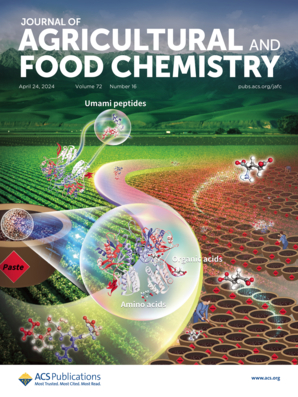Chicoric Acid Differentially Ameliorates Circadian Rhythm Disorder-Induced Liver Glucose Homeostasis Dysregulation in Mice Depending on Intervention Time.
IF 5.7
1区 农林科学
Q1 AGRICULTURE, MULTIDISCIPLINARY
引用次数: 0
Abstract
Dietary phenolic compounds have demonstrated significant potential in preventing shift-work-induced metabolic dysregulation. Meanwhile, chrononutrition has revealed that the intake time of these compounds is closely related to human health. This study explored the effects and potential mechanism of the intervention time of chicoric acid on the improvement of glucose metabolism in a mouse model of the circadian rhythm disorder. Results showed that CA was effective in improving glucose tolerance and restoring the expression levels and phase shifts of clock genes (Bmal1, Per2, Cry2, etc.) and glucose metabolism-related genes (Gck, Pepck, G6pc). Further silencing of Bmal1 in HepG2 cells revealed that CA can act as a biological clock regulator that regulates glucose metabolism-related genes in a Bmal1-dependent manner. Furthermore, we found that CA intervention at ZT12 optimally promoted glucose metabolic homeostasis, and the possible mechanism was that the intervention time coincided with the high expression of Bmal1.根据干预时间,菊苣酸可改善昼夜节律紊乱引起的小鼠肝糖稳态失调。
膳食酚类化合物在预防轮班工作引起的代谢失调方面具有显著的潜力。同时,时间营养学研究表明,这些化合物的摄入时间与人体健康密切相关。本研究探讨了菊苣酸干预时间对改善昼夜节律紊乱小鼠模型糖代谢的影响及其可能机制。结果表明,CA能有效改善糖耐量,恢复生物钟基因(Bmal1、Per2、Cry2等)和葡萄糖代谢相关基因(Gck、Pepck、G6pc)的表达水平和相移。在HepG2细胞中进一步沉默Bmal1表明CA可以作为生物钟调节剂,以Bmal1依赖的方式调节葡萄糖代谢相关基因。此外,我们发现CA干预ZT12对葡萄糖代谢稳态的促进效果最佳,其机制可能与干预时间与Bmal1高表达时间相吻合。
本文章由计算机程序翻译,如有差异,请以英文原文为准。
求助全文
约1分钟内获得全文
求助全文
来源期刊
CiteScore
9.90
自引率
8.20%
发文量
1375
审稿时长
2.3 months
期刊介绍:
The Journal of Agricultural and Food Chemistry publishes high-quality, cutting edge original research representing complete studies and research advances dealing with the chemistry and biochemistry of agriculture and food. The Journal also encourages papers with chemistry and/or biochemistry as a major component combined with biological/sensory/nutritional/toxicological evaluation related to agriculture and/or food.

 求助内容:
求助内容: 应助结果提醒方式:
应助结果提醒方式:


